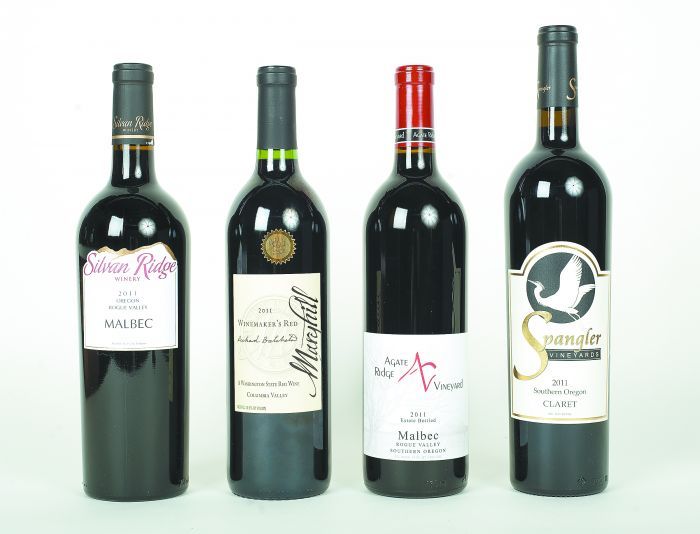Big Red Revelry
France’s famed Bordeaux region is recognized worldwide for a family of winegrapes that produce some of the greatest wines the world has ever known. Jointly referred to as the Bordeaux or Bordelaise varietals, they are Cabernet Sauvignon, Cabernet Franc, Merlot, Petit Verdot, Malbec and Carménère.
Cabernet Sauvignon, Cabernet Franc and Merlot are by far the most widely planted in Bordeaux. Likewise in the U.S., the three have been universally embraced by winemakers, primarily as singly bottled varietals.
In Oregon, these late ripening varieties are planted primarily in the Rogue and Umpqua valleys. As of 2011, total acreages were Cabernet Sauvignon, 640, Merlot, 460, and Cabernet Franc, 120 acres. The varieties also thrive in Washington’s Columbia and Yakima valley AVAs as well as the Walla Walla Valley AVA, which is shared by Oregon and Washington.
Watermill 2008 Merlot, Walla Walla Valley • $24 (330 cases)
Come hither says the seductive vanillin and cassis aroma of this opulent wine. Not just a teaser, it comes through with round, silky flavors of blackberry, currant surrounded by a wisp of wood smoke.
Abacela 2009 Merlot, Southern Oregon $20 • (708 cases)
A drinker that delivers now yet prefers to be laid away. Well-balanced layers of dry yet fleshy flavors include both red and black fruits, chocolate and herbal notes.
Weisinger’s of Ashland 2008 Merlot, Rogue Valley • $26 (378 cases)
Another example of bottle development that has enhanced the aroma with hints of leather, wood, vanillin, smoke and spice. Generous fruit and resolved tannins delight the palate.
Spangler 2009 Cabernet Sauvignon, Southern Oregon • $24 (371 cases)
Heady aromatics of charcoal, cedar and spice introduce stylish taste sensations featuring black currant, ripe cherry, leather and forest floor.
Agate Ridge 2008 Cabernet Sauvignon, Rogue Valley • $24 (383 cases)
A couple of additional years in the bottle reward with the development of depth, smoothness and subtlety. A harmony of silky fruit flavors, including dark berries, cherries and currants, intertwine on the palate complemented by a touch of toasty oak.
Pyrenees 2009 Cabernet Sauvignon, Umpqua Valley • $25 (802 cases)
Loads of sweet, plummy fruit pleases the palate upfront then leads to enticing hints of sweet spice and anise. A long, lingering finish adds accolades to this satisfying sipper.
Seven of Hearts 2010 Chateaux Figareaux Cabernet Franc, Columbia Valley • $29 (98 cases)
Intense extraction of fruit and density of color mark this big boy whose future seems bright. Once firm tannins have resolved, its full potential should show. But by then, it will be long gone.
Spangler 2009 Cabernet Franc, Southern Oregon • $25 (356 cases)
Underscoring its reputation for “big and bold,” Spangler offers up style with size in this weighty, dusty, earthy, fruit-forward wine that offers intriguing flavor elements of cranberry and bell pepper.
Abacela 2009 Estate Malbec, Umpqua Valley • $25 (582 cases)
Abacela’s handful of estate acres constitute much of Malbec’s Pacific Northwest plantings. But the results indicate that perhaps there should be more. A sweet, smoky, floral intro persuades while complex flavors led by dark berries and oak convince. Good balance seals the deal.
Cathedral Ridge 2010 Cab Sauvignon/Merlot, Columbia Valley • $26 (250 cases)
A big, broad-shouldered youth on a 50/50 Cabernet Sauvignon/Merlot frame. Full of promise but already hinting at what’s to come with peppery notes, tangy tar, underlying depth of flavorful fruit and chewy tannins that need more time.
Cana’s Feast 2009 Two Rivers Red Wine, Columbia Valley • $18 (1,155 cases)
Merlot at 42 percent, Cabernet Sauvignon at 32 percent and Cabernet Franc at 16 percent make up most of a classic blend featuring soft, sweet fruit overlaid with chocolate and enhanced by silky tannins. Additional dashes of Primitivo, Petit Verdot and Syrah complete the composition.
Watermill 2008 Estate Midnight Red Wine, Walla Walla Valley • $30 (300 cases)
This wine utilizes all the Bordeaux varieties available in the region. At 60 percent, Cabernet Sauvignon supplies the structure on which the four others — Merlot, Cabernet Franc, Petit Verdot and Malbec — at 10 percent each, build a beautifully balanced blend with plummy fruit enhanced by leather and smoke.
Recommended wines were selected using a double-blind method and a 20-point ranking system for appearance, aroma, taste, balance and finish. The Oregon Wine Press tasting panel has selected the following wines based on overall quality and value within their respective categories. To the best of our knowledge, they are currently available in the marketplace. Wine must be: 1) produced by an Oregon winery; 2) priced (retail) $45 or less for Pinot Noir (October only), $30 or less for other reds (including Pinot Noir tasting in May), $30 or less for Chardonnay, $30 or less for dessert and sparkling wines, and $25 or less for remaining varietals; and 3) currently available to consumers.













